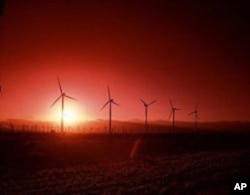Have you ever seen a sunflower twist itself to face into the sun so that it can soak up light energy all day long? Farm windmills used the same principle, rotating into the wind.
Unlike history's first windmills in Persia centuries ago, they did not drive mills to crush grain. They were the visible part of a pumping system, drawing up water for families and livestock from deep underground.
Windmills were introduced to the parched prairie by the railroads, which needed water along the tracks to fill the boilers of their steam locomotives. Farmers quickly borrowed the idea and bought windmills by the tens of thousands from more than 700 manufacturers. Some windmills even came with attachments, like butter churns or belts that turned huge circular saws.
Today, some people collect and display Old West windmills of all sorts. On one, for instance, the blades fold up whenever the wind gets too strong, so it will not blow apart.
Windmills may be rare these days, but wind power is popular. There are entire wind farms in California, Iowa, and elsewhere. But they're fields of fiberglass wind turbines, not wooden windmills.
An array of 3,300 wind turbines in one California mountain pass draws enough energy to supply the entire power needs of the resort city of Palm Springs.
While windmills drove water pumps, wind turbines generate power that goes directly into the electric grid. Turbine owners have discovered the same strengths of wind power that farmers learned a century ago: the wind is a marvelous, non-polluting energy source.
You never run out of it, and the price cannot be beat.







